(2) Mainstreaming of Disaster Risk Reduction, Measures of Disaster Risk Reduction and Post-Disaster Recovery
Disasters including earthquakes, tsunamis, typhoons, floods, droughts, debris flows, etc. that occur frequently around the world do not merely take human lives and property. In developing countries that are vulnerable to disasters, the poor are more likely to be affected significantly and displaced by disasters. In addition, protracted secondary damage such as the deterioration of sanitary conditions and food shortages, can increase the severity of the issue, and have a significant impact on the overall social and economic systems in developing countries.
Therefore, it is necessary to build a disaster-resilient and flexible society to protect human lives from disasters as well as to promote the “mainstreaming of disaster risk reduction” aimed at sustainable development, by incorporating disaster risk reduction measures into every phase of every sector of development, based on assumptions of disasters of various scales.
•Kenya
The Project for Reusing Second-hand Fire Engines in Nairobi City County
Grant Assistance for Grass-Roots Human Security Projects (March 2016 - August 2016)
Nairobi is Kenya's capital with a population of around 3.9 million people and a population density of 5,652 people per square kilometer. However, the city only had three fire stations and just six fire engines, often resulting in late responses whenever a fire broke out. For example, in August 2013, a large fire occurred due to a short circuit from a switchboard at Jomo Kenyatta International Airport, the largest hub airport in East Africa. Delays in firefighting activities caused a serious situation leading to the closure of the entire airport. In December 2014, a fire broke out in Kibera, East Africa's largest slum, and the late response resulted in five deaths and damaged more than 100 houses. Despite frequent occurrences of fires, Nairobi lacked not only a sufficient firefighting system, but also fire engines.
From such backgrounds, Japan provided four secondhand fire engines to the Nairobi Fire Department with the cooperation of the Japan Firefighters Association (JFA) using the Grant Assistance for Grass-Roots Human Security Projects. Three of the four fire engines can carry up to 2,000 liters of water, making it possible to fight fires in locations without a fire hydrant or reservoir. The other fire engine suppresses fire with a chemical that is often used in the situation where water cannot be used, such as at chemical plants.

Photograph taken on the final day of technical assistance
In addition, five Japanese firefighters were dispatched to Nairobi by the JFA to provide training to 24 Kenyan firefighters on how to use and maintain the equipment on the fire engines. They also led Japanese-style firefighter training. This cooperation proved to be deeply meaningful from the standpoint of improving Nairobi's firefighting system by not only donating fire engines, but also transferring the know-how accumulated over a long time by an expert group in Japan (technical guidance).
<Japan's Efforts>
•Cooperation in Disaster Risk Reduction
Japan utilizes its enriched knowledge and technology acquired through the past experiences responding to natural hazards such as earthquakes and typhoons to provide proactive support for disaster risk reduction and post-disaster recovery measures, alongside emergency assistance.
The Third UN World Conference on Disaster Risk Reduction organized by the UN was held in Sendai City in 2015 in order to discuss international disaster risk reduction strategies. Japan hosted the conference, following the first conference in Yokohama in 1994 and the second conference in Kobe in 2005, since Japan has been proactively promoting international disaster risk reduction cooperation by utilizing its expertise and experiences in disaster risk reduction. The third conference was attended by more than 6,500 participants and 185 UN member states, and became one of the largest-ever international conferences held in Japan. The total number of attendees at the conference and its related events exceeded 150,000 from Japan and abroad. The conference resulted in the adoption of the Sendai Declaration as well as the Sendai Framework for Disaster Risk Reduction 2015-2030 (Sendai Framework), which is the successor to the “Hyogo Framework for Action,” the international guiding principle for disaster risk reduction adopted at the second conference. The Sendai Framework incorporated Japan's stance on the importance of investment in disaster risk reduction, commitments of various stakeholders, the concept of “Build Back Better,” the importance of women's leadership, and the “mainstreaming of disaster risk reduction” that applies the concept of disaster risk reduction in all development policies and plans, etc.
Prime Minister Abe also announced the Sendai Cooperation Initiative for Disaster Risk Reduction as a new contribution plan that would become Japan's future basic policy for cooperation in the field of disaster risk reduction. Japan announced provision of training for 40,000 government officials and local leaders and financial cooperation amounting to $4 billion in four years from 2015 to 2018. Through this initiative, Japan demonstrated its attitude to further contribute to the international community by utilizing its advanced expertise and technology in the field of disaster risk reduction. Japan's effort enhanced not only a quality of building structures and improvement of disaster monitoring facilities in each country, but also development of human resources for enactment of laws and plans related to disaster risk reduction, formulation of disaster risk reduction policies, and disaster monitoring. Consequently, the mainstreaming of disaster risk reduction has been promoted in each country.

Coinciding with the World Tsunami Awareness Day, a seminar for tsunami disaster risk reduction was jointly held by JICA and the province of Aceh, Indonesia, in November 2016. (Photo: Shigeki Ishigaki / JICA Indonesia Office)
At the UN summit that adopted the 2030 Agenda in September 2015, Prime Minister Abe expressed Japan's commitment to lead the implementation of the Sendai Framework, and encouraged other countries to set the UN's World Tsunami Awareness Day in order to raise awareness of tsunami. As a result, a resolution adopted at the UN General Assembly in December 2015 established November 5 as World Tsunami Awareness Day. Accordingly, Japan organized the “High School Students Islands Summit on World Tsunami Awareness Day 2017 in Okinawa” for island countries, in Ginowan City, Okinawa Prefecture, on November 7 and 8, 2017.
At the Third Asia-Pacific Water Summit held in Myanmar in December 2017, Japan introduced its policy of “Rebuilding Flood-Conscious Societies” to permanently prepare for water-related disasters throughout the entire society. Japan also proposed to conduct international dialogues by leaders in water disaster risk reduction, aiming at exchanging information on initiatives by each country.
•Nepal
Renovation of Local Community Learning Center for Vulnerable People of Disaster in Changu Narayan Village
Grant Assistance for Japanese NGO Projects (March 2016 - March 2017)
The large earthquake that struck Nepal in April 2015 destroyed the walls and other parts of the Women and Children's Learning Center constructed 15 years earlier by the Institute of Cultural Affairs Japan (ICA) with the assistance of the Government of Japan. Thus, bricks were replaced and repaired while the kitchen, solar panels for electricity, and water tank had to be repaired as well. Japan dispatched experts of structure architecture to check the building's earthquake resistance and construction methods.
Previously, users of the center were mainly local women involved in community reconstruction workshops, but now the consensus is that the center is a venue where both men and women can participate in the events. The center is utilized in various ways. For example, a mental health expert offered mental health services to the children that had experienced mental instability after the earthquake, such as crying at night or wetting their bed. As a result, these services reduced the children's stress and helped them to get enough sleep and regain a healthy appetite. A playground was also set up at the center to help children relieve stress. This, coupled with an environment where mothers could work with peace of mind, helped to restore the smiles on children and their mothers' faces.
The community where this cooperation was carried out has a large number of elderly people living alone, so to prevent their economic and social isolation, a club for them was opened at the center in order to foster communication. The club is led by an executive committee comprising five of the 23 club participants. This committee meets once a month to discuss and determine programs, such as gardening, handicrafts and dancing. Club members who otherwise do not have opportunities to talk with others when at home have commented that every day is fun again because they can talk to their friends at the center.

Women starting to produce sanitary napkins in the local community learning center in Changu Narayan village (Photo: Institute of Cultural Affairs Japan)
Mental health exams conducted by Japanese experts were also provided for those affected by the earthquake. Local staff helped these people to restore a positive thinking process, which has made it possible for participants who were mentally affected by the earthquake to gradually overcome their difficulties.
In addition, rural Nepalese villages have a prejudice against women's menstrual period such as isolating them in one corner of the house and forbidding them from going to school during this time. The center began making clean, high quality and affordable sanitary napkins so that young women in the community can attend school without worry. Women affected by the earthquake were given technical training on how to manufacture these sanitary napkins as part of a project to improve women's income in rural villages.
Through these efforts, activities for increasing poor families' income, were restarted after the earthquake, and users of the center totaled 8,047 people as of March 9, 2017. Today, the center continues to function as a hub of community activities.
